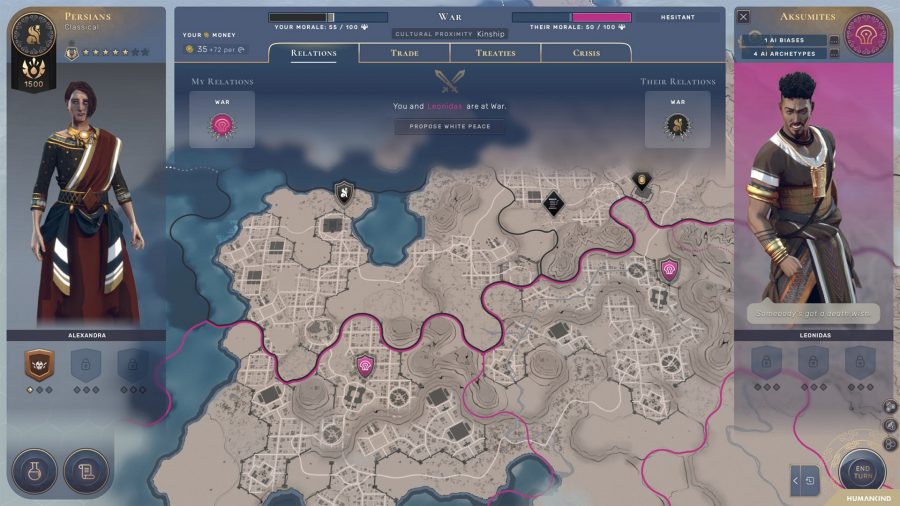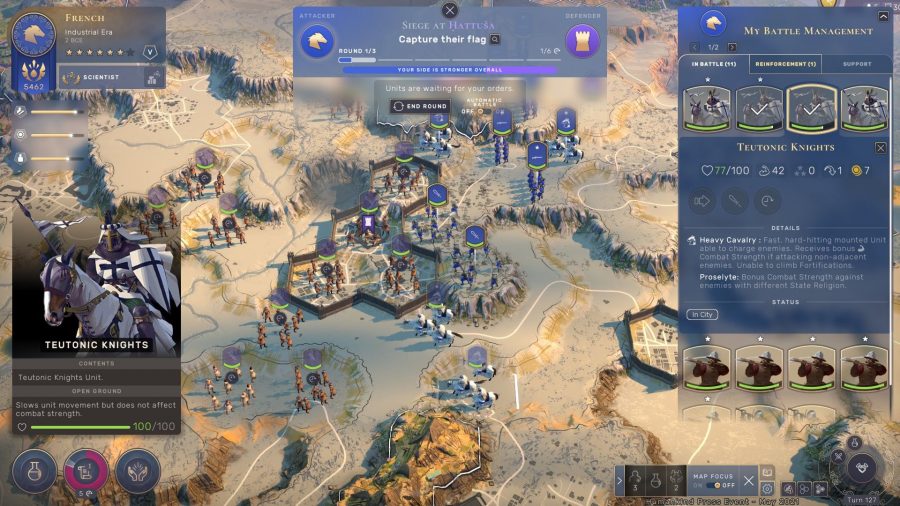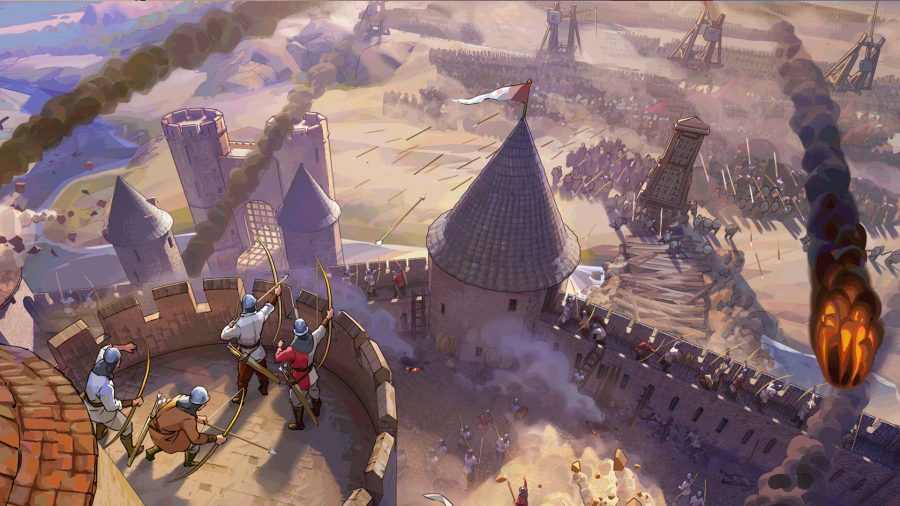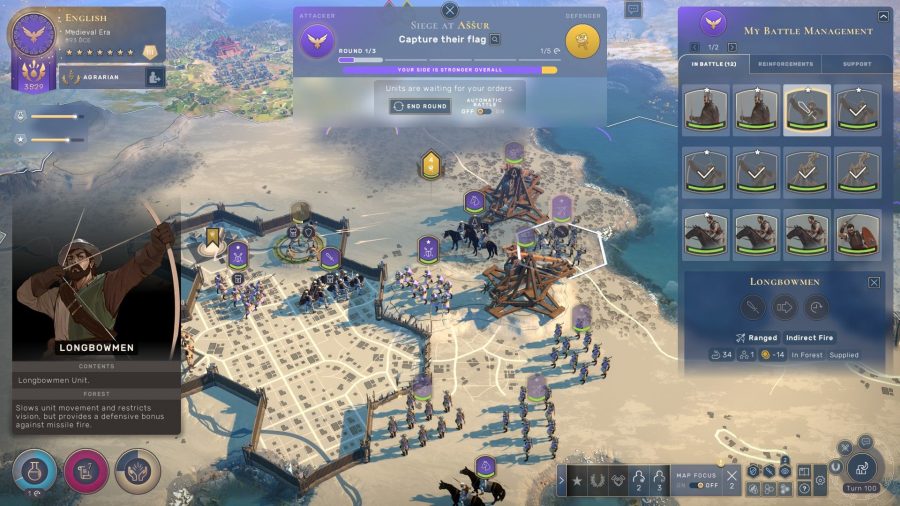Looking for Humankind warfare tips? Unless you’re playing on peaceful mode, chances are you’re going to be clashing with your competitors over the course of your game as you jostle for first place and those sought-after fame points for that ultimate victory.
In the early game, your first fight might be with bears or mammoths, but as leaders begin to stake claims on the territories surrounding their first city, you can expect skirmishes to occur between the various armies roaming the lands. Before borders are established, this doesn’t immediately lead to all-out war, but it’ll contribute to the ever-changing balance of ‘war support’ between nations. War support represents your people’s appetite for war, and determines whether you’re able to continue the fight, or find yourself with no choice but to give in to your enemies’ demands.
Individual battles themselves are also relatively complex turn-based tactical affairs that encourage you to manually direct your units in order to achieve the best possible outcome. Here’s everything you need to know about combat, wars, and battles in Humankind – good luck taking over the world.
Humankind war
When you open your diplomacy tab, you can see the current state of affairs between you and your competitors. At the top of the screen, the war support meter measures how much support you have from your people for fighting with that civilisation, and vice versa.
During active war, if a nation’s war support reaches zero, they are forced to surrender. The exact terms of that surrender will depend on how much war support the victor has remaining; if you’ve won, you’ll notice that each of the terms you can demand – such as forcing them to cede their cities to you – will cost a number of points. The total points you have available is determined by your remaining war support. If you only have a trickle, you’ll walk out of the war with your original grievances settled and a little reparation money. If you have the full 100 war support left, you can expect multiple cities or maybe even a vassalage. This is why war support is such a big deal.
A chunk of war support is granted or lost when you win or lose a battle (as well as if one side opts to retreat from a battle), and certain circumstances deplete or add to your war support on an ongoing, turn-by-turn basis – for example, for every turn you occupy an enemy city, their war support diminishes. You’ll also lose more war support over time if you started the war, if you’re ideologically compatible with your opponent, or if it’s an unjust or surprise war (one started with less than 80 war support).
More like this: The best 4X games on PC
Even during peacetime, accumulating war support (and draining your opponents’) is an important part of the game, as you’re putting yourself at a major disadvantage by letting a competitor accrue a large amount of support against you. Outside of war itself, war support is generated by having more demands active against a rival than they have against you, and by accepting a rival’s demands against you. Refusing their demands gives them the opportunity to declare war without a war support penalty on that turn only.
Warring nations can also propose surrender and offer terms to the other player, or offer a ‘white peace’, which is effectively a tie – the nations are restored to peace and no reparations are made.
Humankind combat
When two opposing armies clash, or an enemy army approaches a city, you will see a tooltip above the two parties in conflict, showing the approximate power balance between them. If you are considering initiating the battle, you can hold down right click on the enemy army to see a preview of the battlefield deployment zones when attacking from a particular angle.
Consider your approach carefully, as the terrain you’re fighting on is just as important as the strength of the units you’re fighting with. Having the high ground, tree cover, or flanking allies is advantageous; crossing a river to attack, or attacking uphill, will give your units a combat penalty. These variables can be enough to change the course of the entire battle.
Vision is also crucial. Units cannot attack enemies they cannot see. Units outside the battlefield can provide vision onto the field, and units can’t see into forest tiles they’re not adjacent to. This means you can set up an ambush by hiding your troops in the forest where your foe won’t see them.
Once you have decided to commit to a fight and move your troops in, or you have been approached by a foe, open up the battle information and you are presented with three choices:
Retreat
If there is a free tile outside of the battlefield that your troops are able to reach, you may retreat to it. This will reduce your war support and increase your enemies’ war support. Once you’ve retreated, your army is not able to retreat again next turn.
If you retreat while defending a city, you relinquish control of that city. AI opponents can and do also retreat from fights, granting you a bonus to your war support.
Instant Resolution
This automatically resolves the battle. Note that this does not necessarily mean you automatically win if you have an advantage over your opponent, nor that all your units will survive even if you do – auto-resolving battles tends to give a much worse outcome than fighting them manually. Therefore, we recommend you only choose this option if you have an overwhelming advantage over your opponent. You can only instantly resolve battles in multiplayer if both sides agree to it.
Manual Resolution
This option allows you to deploy your units to the battlefield and position them as you wish, and then decide where to move units and which enemies to attack each turn. This allows you to make use of flanking bonuses, terrain bonuses, and favourable unit type matchups to turn the battle your way. Though you move your units around the map in grouped ‘armies’, you will deploy them in battle as individual units, one per hex.
Before you carry out an attack with one of your units, you will see the potential damage ranges above each unit involved in the skirmish.
Humankind combat tips
The number of turns taken in each battle is determined by the number of units involved. Battles can even span more than one turn, as only three combat rounds are taken per turn. After researching the requisite technology (Organised Warfare, relatively early in the Ancient era) you can add new units to the battle via reinforcements, provided there are some close enough to join in. There is a single square in which reinforcements can arrive for each side – occupy the enemy’s reinforcement tile to prevent them from adding troops to the field.
Be sure to deploy your reinforcements before taking turns with your other units. If all your active units have acted then your turn will end, even if you have reinforcements remaining, and you’ll have wasted their turn
A battle typically ends when one army’s units have been completely wiped out, but it’s worth noting that there is an alternate ‘capture the flag’ style victory condition as well. Both sides will have a ‘camp’ tile on the map that, if captured and held, will instantly end the battle and declare the capturing side the winner.
There are several other concepts worth thinking about as well. Not all unit types can move and attack in the same turn; some unit types can’t scale city walls and thus are of limited help in sieges; and enemy units will exert a zone of control that will restrict your movement. Some unit types, such as cavalry, can ignore zones of control, making them excellent at running around the flanks and attacking weaker ranged units in the pre-industrial eras.
Besieging cities
To attack a city, you can attack any of the districts attached to the capital. This begins a siege, cutting the city off from its surrounding resources. Each turn, the attackers can choose to maintain the siege, gaining progress towards building siege weapons, or if they’re ready, they can assault the city, triggering a battle. Equally, if the defenders are confident enough, they can choose to initiate a battle and break the siege on their turn.
If the attackers win, the city becomes occupied. This does not mean ownership automatically transfers to the occupying nation, however. Keeping the city under your control will deplete the enemy’s war support, and at the end of the war, you will be able to demand that city as part of the surrender negotiations.
Aerial Warfare and bombardments
Certain sophisticated units are able to strike enemy targets without initiating a battle, most notably artillery units and aircraft. Here’s a quick breakdown of how these units work.
The first aircraft are unlocked with the Aeronautics technology in the late Industrial era. After researching this, you’ll need to build an aerodrome district, and can then build your first aircraft, which will spawn in the aerodrome.
There are two types of aircraft: fighters and bombers. The former can be assigned to patrol territories to defend them from enemy air raids, and both fighters and bombers can be instructed to carry out airstrikes on particular tiles. Bombers are much more effective at this, but can’t defend themselves from enemy fighters. Note that airstrikes damage all units and buildings in the area – not just your enemies’. Missiles work similarly, but are housed in missile silos and destroyed after a single use. This is where you’ll also eventually house nuclear missiles once you’ve researched them.
Any unit with the ‘bombard’ ability can launch long-range artillery strikes on any target you choose without needing to enter battle, with a similar area-of-effect as airstrikes. The prime examples of these are siege artillery and battleships, though the powerful Chinese Emblematic Unit, Guardians, can use the bombard action twice in one turn.
Related: Five strategy games like Civilization
You should hopefully now be prepared to cross swords with your foes – if you’re interested in learning more about the leaders that rule your rival nations, see our AI Personas guide. If you’re struggling, why not alter some of Humankind’s difficulty settings.
{“schema”:{“page”:{“content”:{“headline”:”Humankind war – combat tips to win battles”,”type”:”guide”,”category”:”humankind”},”user”:{“loginstatus”:false},”game”:{“publisher”:”Sega”,”genre”:”Strategy Gamer”,”title”:”Humankind”,”genres”:[“Strategy Gamer”,”Simulation”]}}}}






